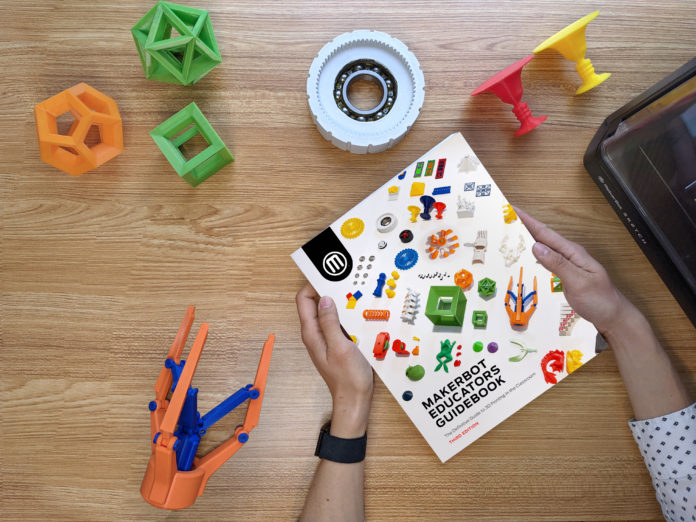MakerBot has released the newest edition of its MakerBot Educators Guidebook, a free and comprehensive resource designed to advance the learning curve of lessons with 3D printing in classrooms.
It has been over a decade that the Stratasys company has been working on bridging the gap between classroom learning and 3D printing.
With new projects plans, design inspiration and ideas, best practices, industry examples, and more, the 3D printer manufacturer says The MakerBot Educators Guidebook provide educators with ideas to enrich their curriculum, enhance student learning, and redefine what 3D printing in education looks like.
“Over the past twelve years, we’ve worked closely with educators around the world who have realized 3D printing’s potential to demonstrate ideas and principles in a new light and engage with students on a whole new level,” said Nadav Goshen, CEO, MakerBot. “Integrating 3D printing into schools is no longer a question of why, but of how. During our 3D Printing in Education Summit, we heard directly from students and teachers who shared stories on how the technology impacted their education and the importance of expanding access to it across different grade levels,” Goshen continued. “We believe that equipping students with tools and resources will better prepare them for the future and help drive success along the way.”
As a reminder, due to its versatility, 3D printing enables the creation of manipulatives and teaching models that can boost project-based learning methods, changing therefore how subjects are taught in schools.
From exploring clear STEM applications in engineering and physics, to understanding mathematical theorems, to blending cross-curricular projects involving history, music, foreign languages, and more, using 3D printing fosters the development of critical thinking, problem-solving, and communications skills in students, skills in a nutshell that will be pivotal in their personal and professional life.
“There are so many ways that 3D printing can enhance the curriculum and help students engage in authentic learning,” said Beverly Owens, guidebook co-author and 11th Grade Chemistry Teacher at Cleveland Early College High School. “I introduced my students to different aspects and applications of 3D printing, and allowed them the opportunity to print out their own designs. Providing tiered support and guidance for students has transformed my classroom into an environment in which students can iterate on designs and solve problems using technology.”
MakerBot explains in a press communication that some of the book’s project examples include creating a “cell city” to learn how organelles function within a cell, designing a planetary gear system to study the different components, studying the mechanics of hand movement with robotic hands, and visualizing trilobites to better understand the organisms.
Some of these projects, and more, can be found on Thingiverse.
Its key chapters in the new guidebook include:
- The Ins and Outs of 3D Printing in the Classroom: Learn how to apply 3D printing in the classroom, adapt the curriculum to hybrid or remote settings, and integrate design thinking as part of the learning cycle.
- The X, Y, and Zs of 3D Printing: Learn the overall process of transforming a digital concept into a physical product, from start to finish.
- Get to Know Your MakerBot Printer: Dive into the main functionalities of MakerBot’s METHOD and SKETCH 3D printers, and learn how to best use MakerBot CloudPrint™ to slice, manage, and print projects.
- Curriculum Project Ideas and Inspirations: Find carefully curated projects and design inspirations spanning Natural Sciences, Engineering, Robotics, Mathematics, and Art, History, and Music.
- Teachers’ Tricks of the Trade: Discover different tips and tricks that other educators have learned in their 3D printing journey.
- 3D Printing Beyond the Classroom: See how 3D printing is impacting industries today and how these applications can be applied back into the classroom.
The new MakerBot Educators Guidebook can be used as a complementary resource to the first two books, MakerBot in the Classroom and the original MakerBot Educators Guidebook.
Remember, you can post job opportunities in the AM Industry on 3D ADEPT Media free of charge or look for a job via our job board. Make sure to follow us on our social networks and subscribe to our weekly newsletter : Facebook, Twitter, LinkedIn & Instagram ! If you want to be featured in the next issue of our digital magazine or if you hear a story that needs to be heard, make sure you send it to contact@3dadept.com






